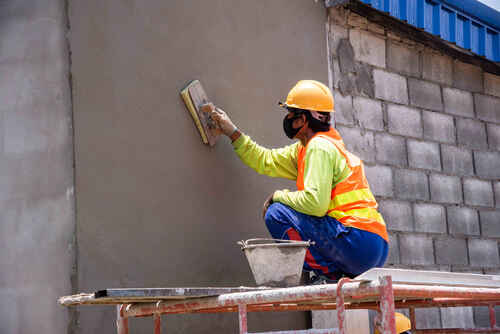Common Blunders to Prevent When Taking On a Plastering Job
Common Blunders to Prevent When Taking On a Plastering Job
Blog Article
A Comprehensive Guide to Mastering Plastering Abilities for Your Renovation Needs

Vital Tools and Products
Different crucial tools serve distinctive functions, guaranteeing efficiency and precision throughout the plastering procedure. A top quality trowel, for circumstances, is crucial for smoothing and applying plaster, while a hawk gives a stable system for holding the material.
Along with devices, choosing the ideal plastering materials is crucial. Gypsum-based plasters are frequently liked for their adaptability and convenience of usage, while cement-based options are ideal for exterior applications due to their sturdiness. Water and bonding agents play significant roles in accomplishing proper uniformity and bond, making certain that the plaster adheres properly to the surface.
Additionally, protective gear such as gloves, masks, and goggles is necessary to protect versus dust and inflammation during the application procedure. By constructing the appropriate mix of products and devices, plasterers can boost their ability collection and create top quality finishes, inevitably raising the overall craftsmanship of their job.
Preparing Surfaces for Smudging
Accomplishing a smooth and long lasting plaster coating begins with precise prep work of the surfaces to be plastered. This foundational action is essential to guaranteeing adhesion and the longevity of the plaster. Start by analyzing the condition of the substrate-- whether it is drywall, concrete, or stonework-- removing any loose paint, dust, or debris that may conflict with bonding.
Next, fix any kind of blemishes such as openings or fractures. Use an appropriate filler to accomplish a level surface; this can be essential for stopping future problems. As soon as repaired, guarantee the surface is clean and completely dry, as dampness can compromise plaster adherence.
For porous surfaces, it is recommended to apply a bonding representative. This product boosts bond and creates a trustworthy interface in between the plaster and substrate. If dealing with formerly plastered surface areas, it may be essential to mess up or sand the location lightly to supply a trick for the brand-new plaster layer.
Smudging Strategies and Tips
Grasping gluing techniques calls for both ability and practice to accomplish a perfect surface. One essential strategy is the application of the plaster in multiple slim layers, instead than a single thick coat. This method permits for much better bond and reduces the risk of breaking. Begin with a skim coat, guaranteeing it is uniformly spread out and leveled with a hawk and trowel. Make use of a straightedge to look for any kind of flaws before going on to succeeding layers.
When using the coating coat, utilize a troweling method that involves holding the trowel at a small angle and functioning in a round activity. This helps to create a smooth surface area go and minimizes the look of trowel marks. In addition, maintain a spray bottle of water helpful to haze the surface gently; this keeps the plaster practical and enables smoother completing.
Timing is important; job efficiently, as the plaster starts to establish. As soon as the plaster has actually firmed up but is still wet, make use of a moist sponge to delicately smooth the surface area additionally. Finally, enable sufficient drying out time prior to sanding or painting, guaranteeing your effort causes a specialist, top notch finish.
Common Errors to Stay Clear Of

One more usual mistake is using plaster too heavily. Overzealous applications can cause fracturing and long term drying times. It's important to apply plaster in thin, also layers, allowing each layer to completely dry adequately before adding extra.
Furthermore, not making use of the right tools can hinder the high quality of the surface. Utilizing unsuitable trowels or mixers can produce variances in the smudging procedure. Always decide for high-quality devices created for smudging tasks.
Finally, many individuals undervalue the significance of timing. Functioning in improper temperatures or moisture degrees can adversely influence plaster drying and treating. It is recommended to examine weather and adapt your routine as necessary.
Finishing Touches for an Expert Look
The lasts of a smudging job are important for attaining a sleek, specialist look. When the plaster has actually dried completely, the next step is to analyze the surface area for imperfections. Minor bumps, holes, or unequal locations must be addressed utilizing great sandpaper or a fining sand block. This meticulous interest to detail is necessary for making sure a smooth finish.
After fining sand, it's advisable to clean the surface area to remove any kind of dust and particles. A wet cloth is reliable for this function, adhered to by a comprehensive drying duration. If essential, applying a thin layer of ending up plaster can boost the surface further, supplying a smooth finish.
Once the finishing plaster is completely dry, another round of sanding may be called for to achieve the preferred level of smoothness. Finally, take into consideration applying a guide prior to paint more or wallpapering, which will certainly improve bond and resilience.
Verdict
Mastering gluing abilities dramatically boosts the top quality of improvement tasks. A comprehensive understanding of essential tools, surface area prep work, and effective strategies is vital for Discover More attaining expert outcomes. Understanding of common blunders permits for the avoidance of pricey mistakes, while interest to finishing touches guarantees a refined look. Ultimately, the combination of these components adds to the production of smooth, resilient surfaces that raise the visual value of any type of space, highlighting the significance of skillful plastering in home enhancement ventures.
Water and bonding representatives play significant roles in achieving proper uniformity and adhesion, making certain that the plaster adheres effectively to the surface area. Plastering.


Additionally, keep a spray container of water helpful to mist the surface gently; this maintains the plaster practical and allows for smoother ending up. (Plastering)
If needed, applying a thin layer of ending up plaster can improve the surface better, offering a seamless coating.
Report this page